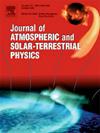层状降水中的雨滴大小分布:来自西高止山脉高空云物理观测站的光谱仓模拟的见解
IF 1.9
4区 地球科学
Q3 GEOCHEMISTRY & GEOPHYSICS
Journal of Atmospheric and Solar-Terrestrial Physics
Pub Date : 2025-09-17
DOI:10.1016/j.jastp.2025.106643
引用次数: 0
摘要
从bin微物理方案中得到的雨滴大小分布(RSD)的理解对于改善降雨估计和阐明西高止山脉复杂地形上的云微物理过程至关重要。本文利用气象研究与预报(WRF)快速版谱仓微物理方案(SBM-Fast)模式的模拟,以及Munnar高空云物理观测站(HACPO)微雨雷达和ceilometer的同步观测资料,研究了RSD的结构和演变。分析了三个延长的层状事件(>2 h),以检查熔化层结构、雨滴生长和RSD垂直变化的关键微物理特征。MRR和模式结果表明,熔融层以下(~ 4.8 km)的RSD明显增加。SBM显示熔融层下雨水混合比增强,与观测到的RSD增长一致。在融化层之上,高空的霰和雪有助于雨滴的生长。该模式倾向于高估地表附近1-2毫米范围内的中等大小雨滴,导致对层状降水的高估。正如模型模拟所捕捉到的那样,颗粒生长的增强和随后的水成物装载是由垂直风和更高的上升气流支持的。本文章由计算机程序翻译,如有差异,请以英文原文为准。
Raindrop size distribution in stratiform precipitation: Insights from spectral bin simulations over the high-altitude cloud physics observatory, Western Ghats
An understanding of the Raindrop Size Distributions (RSD) derived from the bin microphysics scheme is vital for improving rainfall estimates and elucidating cloud microphysical processes over the complex terrain of the Western Ghats. This study investigates the structure and evolution of RSD using simulations from the Weather Research and Forecasting (WRF) model with the fast version of the spectral bin microphysics scheme (SBM-Fast), and co-located observations from the micro rain radar and ceilometer at the High-Altitude Cloud Physics Observatory (HACPO), Munnar. Three prolonged stratiform events (>2 h) are analysed to examine key microphysical signatures of melting layer structure, raindrop growth, and vertical variation in RSD. MRR and model results indicate a clear increase in RSD below the melting layer (∼4.8 km). The SBM shows an enhanced rainwater mixing ratio beneath the melting layer, in agreement with observed RSD growth. Above the melting layer, graupel and snow aloft contribute to the growth of raindrops. The model tends to overpredict mid-sized raindrops in the range 1–2 mm near the surface, leading to an overestimation in rainfall for the stratiform case. The enhanced particle growth and subsequent hydrometeor loading were supported by vertical wind with higher updrafts, as captured by the model simulation.
求助全文
通过发布文献求助,成功后即可免费获取论文全文。
去求助
来源期刊

Journal of Atmospheric and Solar-Terrestrial Physics
地学-地球化学与地球物理
CiteScore
4.10
自引率
5.30%
发文量
95
审稿时长
6 months
期刊介绍:
The Journal of Atmospheric and Solar-Terrestrial Physics (JASTP) is an international journal concerned with the inter-disciplinary science of the Earth''s atmospheric and space environment, especially the highly varied and highly variable physical phenomena that occur in this natural laboratory and the processes that couple them.
The journal covers the physical processes operating in the troposphere, stratosphere, mesosphere, thermosphere, ionosphere, magnetosphere, the Sun, interplanetary medium, and heliosphere. Phenomena occurring in other "spheres", solar influences on climate, and supporting laboratory measurements are also considered. The journal deals especially with the coupling between the different regions.
Solar flares, coronal mass ejections, and other energetic events on the Sun create interesting and important perturbations in the near-Earth space environment. The physics of such "space weather" is central to the Journal of Atmospheric and Solar-Terrestrial Physics and the journal welcomes papers that lead in the direction of a predictive understanding of the coupled system. Regarding the upper atmosphere, the subjects of aeronomy, geomagnetism and geoelectricity, auroral phenomena, radio wave propagation, and plasma instabilities, are examples within the broad field of solar-terrestrial physics which emphasise the energy exchange between the solar wind, the magnetospheric and ionospheric plasmas, and the neutral gas. In the lower atmosphere, topics covered range from mesoscale to global scale dynamics, to atmospheric electricity, lightning and its effects, and to anthropogenic changes.
 求助内容:
求助内容: 应助结果提醒方式:
应助结果提醒方式:


